Áp dụng phần mềm Quizlet nhằm tạo nên sự tự chủ của người học trong việc học từ vựng tiếng Anh của sinh viên
Bài báo này trính bày một số kết quả quan trọng của một nghiên cứu
gần đây về việc áp dụng Quizlet trong giảng dạy tiếng Anh. Một trong
hai mục tiêu của nghiên cứu này là xem xét người học tự chủ như thế
nào trong việc học từ vựng. Sáu mươi sinh viên năm thứ hai đến từ
trường Đại học Kinh tế và Quản trị kinh doanh – Đại học Thái Nguyên
đã tham gia vào nghiên cứu kéo dài 10 tuần. Trong năm tuần đầu tiên,
sinh viên được dạy mà không có sự áp dụng của Quizlet, trong khi đó
trong năm tuần tiếp theo của giai đoạn hai, Quizlet được đưa vào để hỗ
trợ việc học từ vựng. Hai bảng câu hỏi khảo sát được chuyển tới các
sinh viên tham gia trước và sau thực nghiệm để khảo sát thái độ học
của sinh viên đối với việc học từ vừng qua Quizlet. Các phân tìch dữ
liệu cho thấy rằng sinh viên cảm thấy thìch thú và háo hức hơn khi học
từ vựng, hơn nữa, sinh viên còn trở nên chủ động và độc lập hơn. Như
vậy, có thể kết luận rằng việc sử dụng Quizlet trong việc dạy từ vựng
tiếng Anh là có lợi cho người học, hỗ trợ việc học độc lập. Hy vọng
rằng, những kết quả này có thể khuyến khìch giáo viên cũng như người
học sử dụng Quizlet thường xuyên hơn trong việc dạy và học tiếng
Anh, đặc biệt là trong thời đại công nghệ hiện đại.
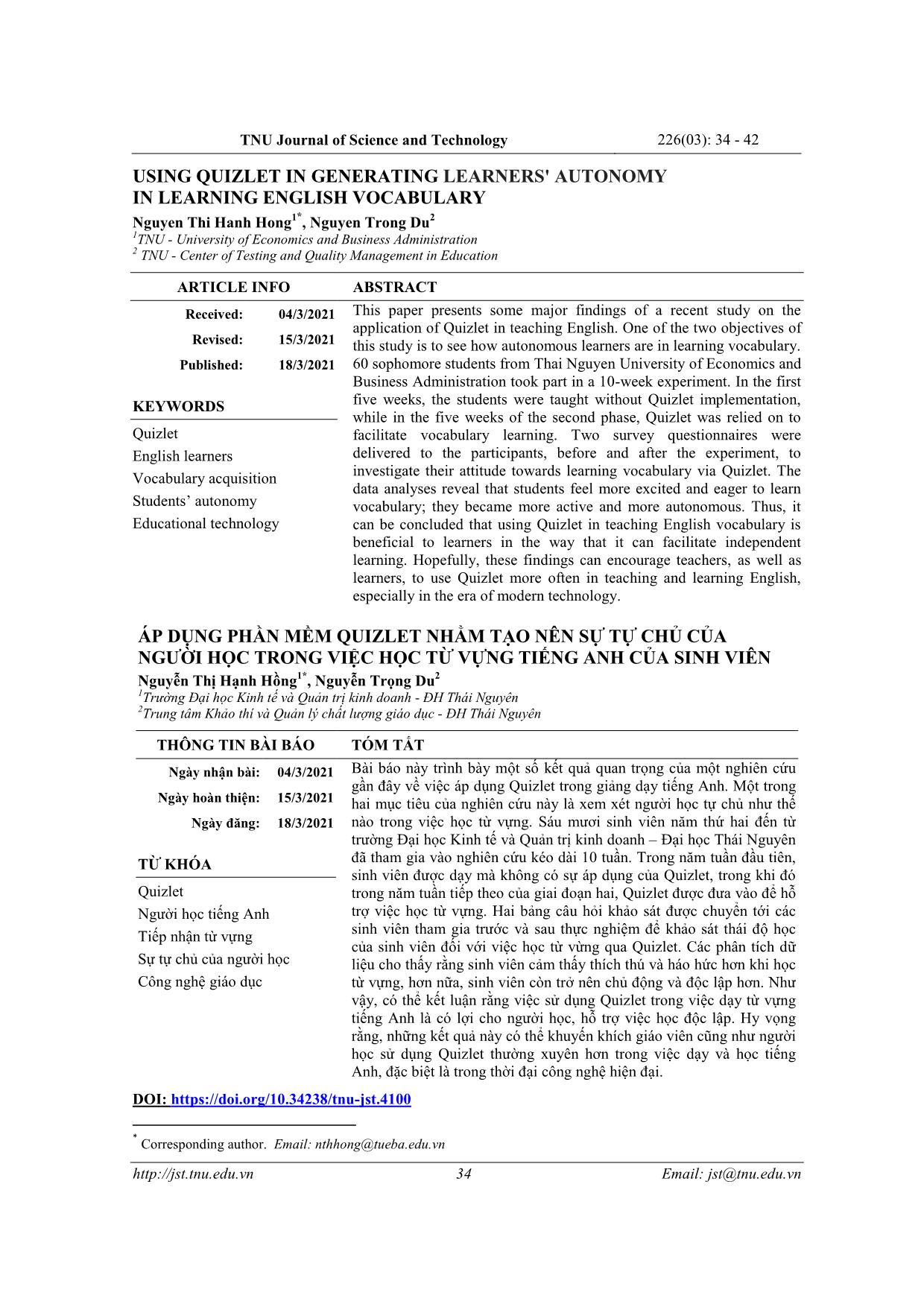
Trang 1
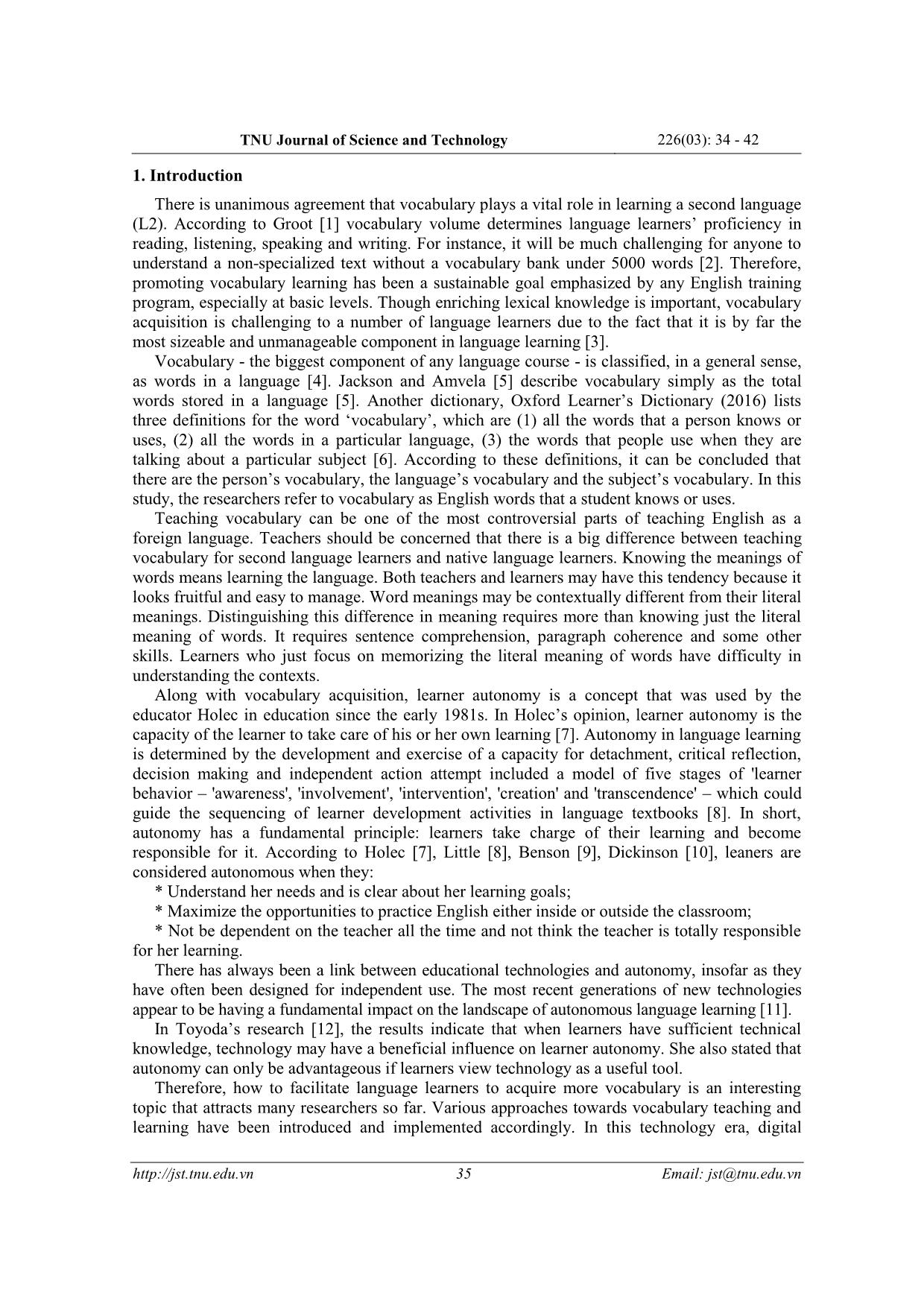
Trang 2

Trang 3
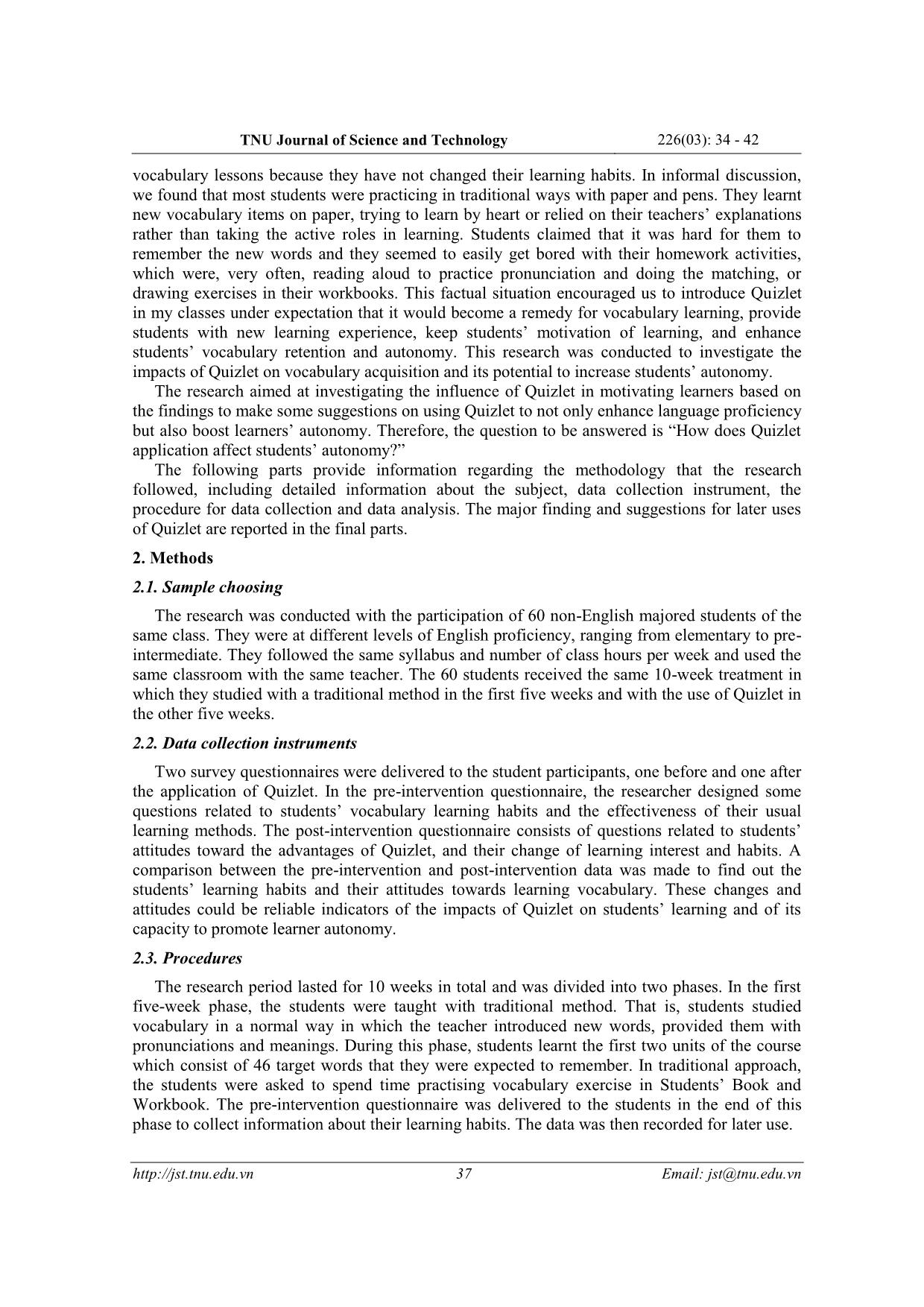
Trang 4

Trang 5
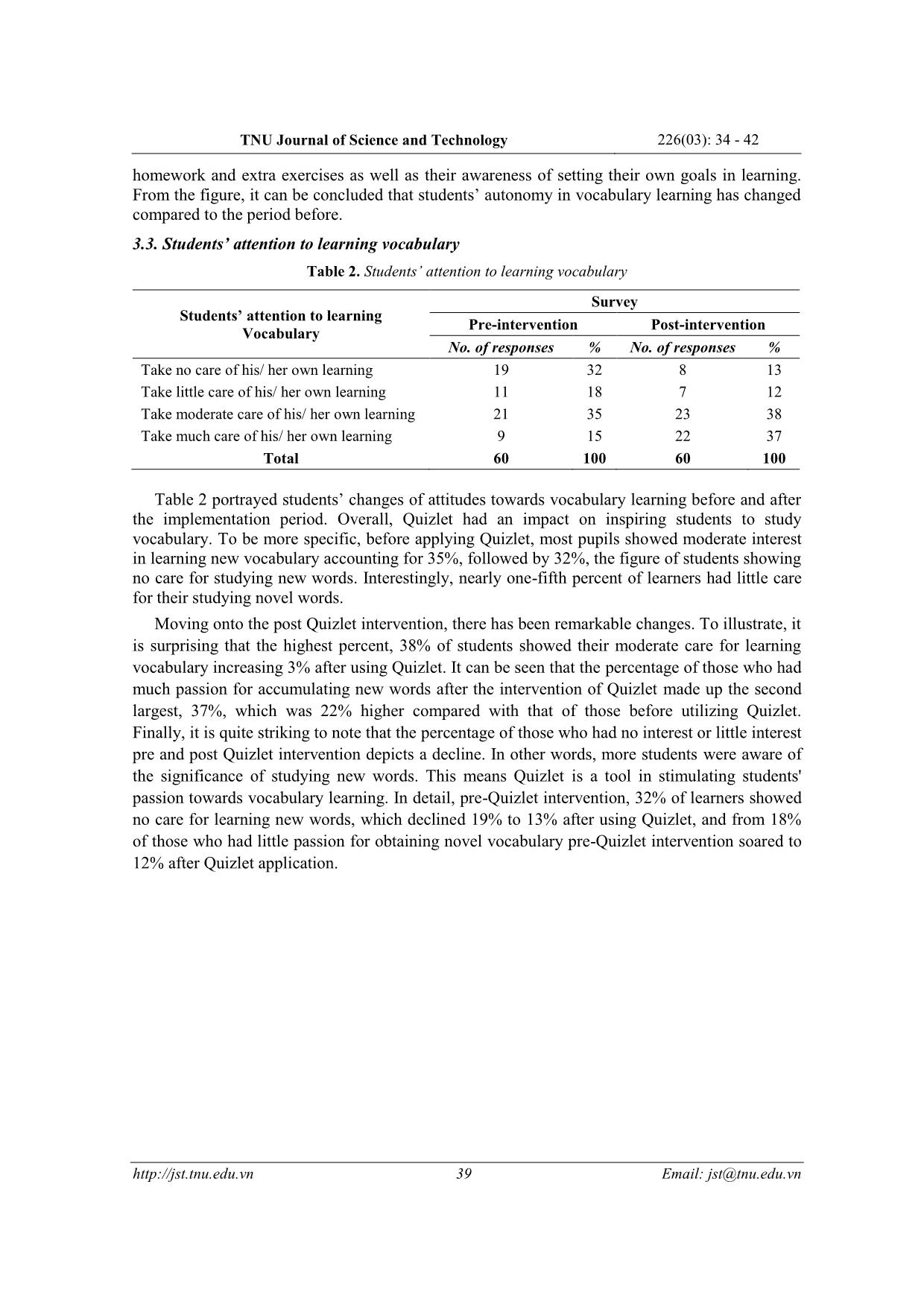
Trang 6
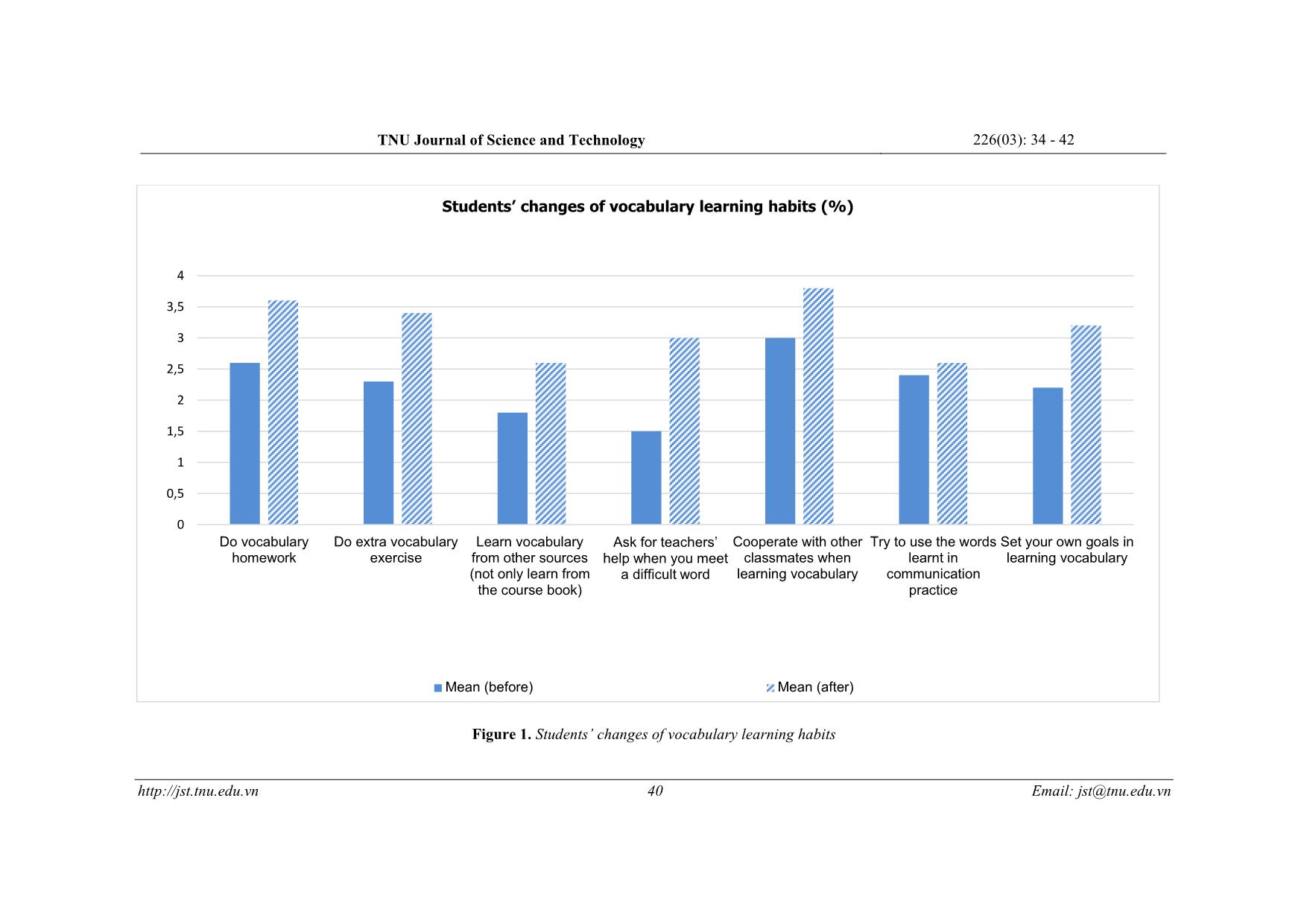
Trang 7
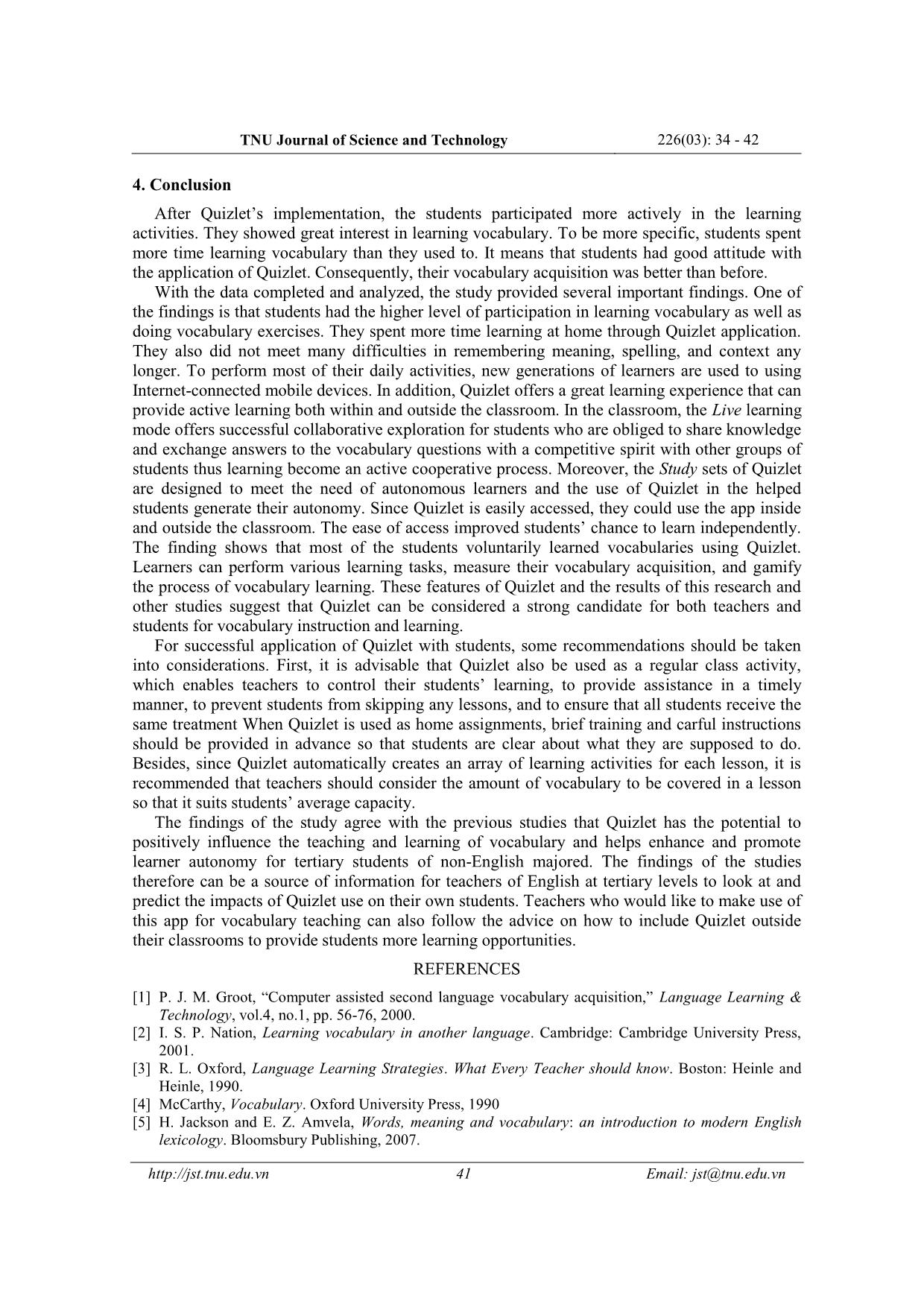
Trang 8

Trang 9
Tóm tắt nội dung tài liệu: Áp dụng phần mềm Quizlet nhằm tạo nên sự tự chủ của người học trong việc học từ vựng tiếng Anh của sinh viên

week and used the same classroom with the same teacher. The 60 students received the same 10-week treatment in which they studied with a traditional method in the first five weeks and with the use of Quizlet in the other five weeks. 2.2. Data collection instruments Two survey questionnaires were delivered to the student participants, one before and one after the application of Quizlet. In the pre-intervention questionnaire, the researcher designed some questions related to students‟ vocabulary learning habits and the effectiveness of their usual learning methods. The post-intervention questionnaire consists of questions related to students‟ attitudes toward the advantages of Quizlet, and their change of learning interest and habits. A comparison between the pre-intervention and post-intervention data was made to find out the students‟ learning habits and their attitudes towards learning vocabulary. These changes and attitudes could be reliable indicators of the impacts of Quizlet on students‟ learning and of its capacity to promote learner autonomy. 2.3. Procedures The research period lasted for 10 weeks in total and was divided into two phases. In the first five-week phase, the students were taught with traditional method. That is, students studied vocabulary in a normal way in which the teacher introduced new words, provided them with pronunciations and meanings. During this phase, students learnt the first two units of the course which consist of 46 target words that they were expected to remember. In traditional approach, the students were asked to spend time practising vocabulary exercise in Students‟ Book and Workbook. The pre-intervention questionnaire was delivered to the students in the end of this phase to collect information about their learning habits. The data was then recorded for later use. TNU Journal of Science and Technology 226(03): 34 - 42 38 Email: jst@tnu.edu.vn In the second phase which also lasted for 5 weeks, the students learned vocabulary in a normal way in class and at home they were asked to practise with exercises on Quizlet. During this time, they were expected to be able to learn 58 new words in the next 2 units. They were required to review the targeted lexical items by completing the compatible Quizlet lesson after every class session. Similar to the first phase, in the end of this phase, the students were also asked to fill out the post-intervention survey. Respondence to survey questionnaires regarding their learning habits and attitudes towards vocabulary learning were also analyzed. 3. Results and discussion 3.1 Students’ self-studying learning habit Table 1 presents the students‟ change of self-studying learning habit. Table 1. Students’ change of self- studying learning habit Frequency of self- studying in general Survey Pre-intervention Post-intervention No. of responses % No. of responses % I study all lessons. 9 15 18 30 I study most lessons. 12 20 22 37 I study some lessons. 27 45 17 28 I never study any lessons. 12 20 3 5 Total 60 100 60 100 The data in table 1 showed that there was an increase of students who studied all lessons to 30%. Similarly, the number of student studying the most lesson experienced an increase to 37%. It can be seen that the percentage of those who spent time studying most lessons accumulating new words after the intervention of Quizlet makes up the first largest, 37% which is 17% higher compared with that of those before utilizing Quizlet. On the contrary, the number of students who studied some lessons reduced by nearly 20%, from 45% at first to 28% after the implementation period. Most notably, the figures for students who never spent any time on studying any vocabulary lessons at home fell from 20% to 5% only. The higher frequency of learning after the introduction of Quizlet implies that this tool made students more willing to learn by themselves. 3.2. The students’ frequency of doing vocabulary learning activities To clarify the differences of the periods before and after the introduction of Quizlet, Figure 1 compares the mean values in terms of each individual criteria. The increase of the mean values in the second period implied the rise of students‟ frequency in learning. As shown in Figure 1, students‟ habits of vocabulary learning moved towards positive direction since all of the figures in the second research period are higher than in the previous one. For all of the questions surveyed, students‟ responses confirmed that they became more autonomous and cooperative in learning. More specifically, the number of students did vocabulary homework, did extra vocabulary exercises increased. Besides the course books, students also found and learned vocabulary from other sources. They were also more active in making questions to their teachers to ask for their help when they had difficulties with new words. In addition, students became more cooperative with other classmates when learning vocabulary. Also, more students tried to use the words learnt in communication practice than the period before. Last but not least, more students were clearer about their learning goals since they started to set their own goals in learning vocabulary. The most significant changes were the frequency of students‟ habits of making questions to their teachers, the times they did their TNU Journal of Science and Technology 226(03): 34 - 42 39 Email: jst@tnu.edu.vn homework and extra exercises as well as their awareness of setting their own goals in learning. From the figure, it can be concluded that students‟ autonomy in vocabulary learning has changed compared to the period before. 3.3. Students’ attention to learning vocabulary Table 2. Students’ attention to learning vocabulary Students’ attention to learning Vocabulary Survey Pre-intervention Post-intervention No. of responses % No. of responses % Take no care of his/ her own learning 19 32 8 13 Take little care of his/ her own learning 11 18 7 12 Take moderate care of his/ her own learning 21 35 23 38 Take much care of his/ her own learning 9 15 22 37 Total 60 100 60 100 Table 2 portrayed students‟ changes of attitudes towards vocabulary learning before and after the implementation period. Overall, Quizlet had an impact on inspiring students to study vocabulary. To be more specific, before applying Quizlet, most pupils showed moderate interest in learning new vocabulary accounting for 35%, followed by 32%, the figure of students showing no care for studying new words. Interestingly, nearly one-fifth percent of learners had little care for their studying novel words. Moving onto the post Quizlet intervention, there has been remarkable changes. To illustrate, it is surprising that the highest percent, 38% of students showed their moderate care for learning vocabulary increasing 3% after using Quizlet. It can be seen that the percentage of those who had much passion for accumulating new words after the intervention of Quizlet made up the second largest, 37%, which was 22% higher compared with that of those before utilizing Quizlet. Finally, it is quite striking to note that the percentage of those who had no interest or little interest pre and post Quizlet intervention depicts a decline. In other words, more students were aware of the significance of studying new words. This means Quizlet is a tool in stimulating students' passion towards vocabulary learning. In detail, pre-Quizlet intervention, 32% of learners showed no care for learning new words, which declined 19% to 13% after using Quizlet, and from 18% of those who had little passion for obtaining novel vocabulary pre-Quizlet intervention soared to 12% after Quizlet application. TNU Journal of Science and Technology 226(03): 34 - 42 40 Email: jst@tnu.edu.vn Figure 1. Students’ changes of vocabulary learning habits 0 0,5 1 1,5 2 2,5 3 3,5 4 Do vocabulary homework Do extra vocabulary exercise Learn vocabulary from other sources (not only learn from the course book) Ask for teachers’ help when you meet a difficult word Cooperate with other classmates when learning vocabulary Try to use the words learnt in communication practice Set your own goals in learning vocabulary Students’ changes of vocabulary learning habits (%) Mean (before) Mean (after) TNU Journal of Science and Technology 226(03): 34 - 42 41 Email: jst@tnu.edu.vn 4. Conclusion After Quizlet‟s implementation, the students participated more actively in the learning activities. They showed great interest in learning vocabulary. To be more specific, students spent more time learning vocabulary than they used to. It means that students had good attitude with the application of Quizlet. Consequently, their vocabulary acquisition was better than before. With the data completed and analyzed, the study provided several important findings. One of the findings is that students had the higher level of participation in learning vocabulary as well as doing vocabulary exercises. They spent more time learning at home through Quizlet application. They also did not meet many difficulties in remembering meaning, spelling, and context any longer. To perform most of their daily activities, new generations of learners are used to using Internet-connected mobile devices. In addition, Quizlet offers a great learning experience that can provide active learning both within and outside the classroom. In the classroom, the Live learning mode offers successful collaborative exploration for students who are obliged to share knowledge and exchange answers to the vocabulary questions with a competitive spirit with other groups of students thus learning become an active cooperative process. Moreover, the Study sets of Quizlet are designed to meet the need of autonomous learners and the use of Quizlet in the helped students generate their autonomy. Since Quizlet is easily accessed, they could use the app inside and outside the classroom. The ease of access improved students‟ chance to learn independently. The finding shows that most of the students voluntarily learned vocabularies using Quizlet. Learners can perform various learning tasks, measure their vocabulary acquisition, and gamify the process of vocabulary learning. These features of Quizlet and the results of this research and other studies suggest that Quizlet can be considered a strong candidate for both teachers and students for vocabulary instruction and learning. For successful application of Quizlet with students, some recommendations should be taken into considerations. First, it is advisable that Quizlet also be used as a regular class activity, which enables teachers to control their students‟ learning, to provide assistance in a timely manner, to prevent students from skipping any lessons, and to ensure that all students receive the same treatment When Quizlet is used as home assignments, brief training and carful instructions should be provided in advance so that students are clear about what they are supposed to do. Besides, since Quizlet automatically creates an array of learning activities for each lesson, it is recommended that teachers should consider the amount of vocabulary to be covered in a lesson so that it suits students‟ average capacity. The findings of the study agree with the previous studies that Quizlet has the potential to positively influence the teaching and learning of vocabulary and helps enhance and promote learner autonomy for tertiary students of non-English majored. The findings of the studies therefore can be a source of information for teachers of English at tertiary levels to look at and predict the impacts of Quizlet use on their own students. Teachers who would like to make use of this app for vocabulary teaching can also follow the advice on how to include Quizlet outside their classrooms to provide students more learning opportunities. REFERENCES [1] P. J. M. Groot, “Computer assisted second language vocabulary acquisition,” Language Learning & Technology, vol.4, no.1, pp. 56-76, 2000. [2] I. S. P. Nation, Learning vocabulary in another language. Cambridge: Cambridge University Press, 2001. [3] R. L. Oxford, Language Learning Strategies. What Every Teacher should know. Boston: Heinle and Heinle, 1990. [4] McCarthy, Vocabulary. Oxford University Press, 1990 [5] H. Jackson and E. Z. Amvela, Words, meaning and vocabulary: an introduction to modern English lexicology. Bloomsbury Publishing, 2007. TNU Journal of Science and Technology 226(03): 34 - 42 42 Email: jst@tnu.edu.vn [6] Oxford Learner‟s Dictionary, 1st ed. [Online]. Available: com/definition/english/vocabulary?q=vocabulary. [Accessed January 15, 2020]. [7] H. Holec, Autonomy and Foreign Language Learning. Oxford/New York: Pergamon Press, 1981. [8] D. Little, Learner Autonomy Definitions, Issues and Problems. Dublin Authentik, 1991 [9] P. Benson, Teaching and Researching Autonomy in Language Learning. Essex. Pearson Education Ltd, 2001. [10] L. Dickinson, Self-instruction in Language Learning. Cambridge University Press, 1987. [11] P. Benson, and A. Chik, “New literacies and autonomy in foreign language learning,” in Digital genres, new literacies and autonomy in language learning, M. J. Luzon, M. N. Ruiz, & M. L. Villanueva, Eds. Newcastle upon Tyne: Cambridge Scholars Publishing, 2010, pp. 63-80. [12] E. Toyoda, “Exercise of Learner Autonomy in Project-Oriented CALL,” CALL-EJ Online, vol. 2, no. 2, 2002. [Online]. Available: [Accessed January 13, 2020]. [13] R. J. Ashcroft and A. C. Imrie, “Learning vocabulary with digital flashcards,” JALT2013 Conference Proceedings, Tokyo: JALT, 2014, pp. 639-646. [14] G. Dizon, "Quizlet in the EFL classroom: Enhancing academic vocabulary acquisition of Japanese universitystudents," Teaching English with Technology, vol. 16, no. 2, pp.40-56, 2016. [15] C. M. Kose, "Perceptions of EFL learners about using an online tool for vocabulary in EFL classrooms: A Pilot Project in Turkey," Procedia - Social and Behavioral Sciences, vol. 232, pp. 362- 372, 2016. [16] Lander, "Quizlet: what the students think – a qualitative data analysis," in CALL communities and culture – short papers from EUROCALL 2016, S. Papadima-Sophocleous, L. Bradley and S. Thouësny, Ed., 2016, pp. 254-259. [17] Anjaiputra and Salsabila, “The merits of Quizlet for Vocabulary Learning at Tertiary Level,” Indonesian EFL Journal, vol. 4, no. 2, pp.1-11, 2018. [18] R. Kálecký, “Quizlet vs. vocabulary notebook: The impact of different methods of storing and revising vocabulary on students' progress, retention, and autonomy,” Master thesis, Masaryk University, 2016.
File đính kèm:
 ap_dung_phan_mem_quizlet_nham_tao_nen_su_tu_chu_cua_nguoi_ho.pdf
ap_dung_phan_mem_quizlet_nham_tao_nen_su_tu_chu_cua_nguoi_ho.pdf

